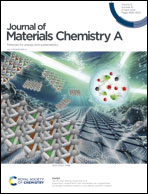Molecular engineering with CuanCl for effective optimization of a defective interface for wide-bandgap perovskite solar cells†
Abstract
In wide-bandgap (WBG) perovskite solar cells (PSCs), the energy level misalignment between the hole transport layer (HTL) and the perovskite layer, coupled with the high-density defects at their buried interface, causes severe non-radiative recombination within PSCs. Herein, CuanCl (carbamoyl-guanidine amidino urea salt, hydrochloride salt) with multifunctional molecular groups is introduced to optimize the WBG perovskite/HTL interface. This strategic introduction aims to suppress non-radiative recombination, consequently mitigating open-circuit voltage loss (Vloss). The findings demonstrate the bifunctional chemical passivation effect of the carbonyl (C![[double bond, length as m-dash]](https://www.rsc.org/images/entities/char_e001.gif) O) and imine cations (
O) and imine cations (![[double bond, length as m-dash]](https://www.rsc.org/images/entities/char_e001.gif) NH+–) within CuanCl molecules on surface defects of perovskite, effectively suppressing diverse defect-assisted non-radiative recombination. Furthermore, the surface-bound CuanCl on the perovskite provides supplementary electronic states at the valence band maximum, achieving a more harmonized energy level alignment and effectively inhibiting charge recombination at the interface. The resultant CuanCl-treated WBG PSCs produce a high open-circuit voltage of 1.27 V, and a decent fill factor of 77.28%, which leads to a power conversion efficiency of 19.36%. Furthermore, the devices exhibit superior stability, maintaining 84% of their initial efficiency after 1000 hours in air with a humidity of 40%. This work provides new insight for optimizing a defective interface with the molecular engineering approach for fabricating efficient and stable WBG PSCs.
NH+–) within CuanCl molecules on surface defects of perovskite, effectively suppressing diverse defect-assisted non-radiative recombination. Furthermore, the surface-bound CuanCl on the perovskite provides supplementary electronic states at the valence band maximum, achieving a more harmonized energy level alignment and effectively inhibiting charge recombination at the interface. The resultant CuanCl-treated WBG PSCs produce a high open-circuit voltage of 1.27 V, and a decent fill factor of 77.28%, which leads to a power conversion efficiency of 19.36%. Furthermore, the devices exhibit superior stability, maintaining 84% of their initial efficiency after 1000 hours in air with a humidity of 40%. This work provides new insight for optimizing a defective interface with the molecular engineering approach for fabricating efficient and stable WBG PSCs.



 Please wait while we load your content...
Please wait while we load your content...